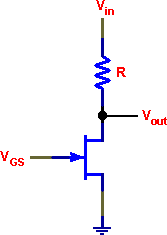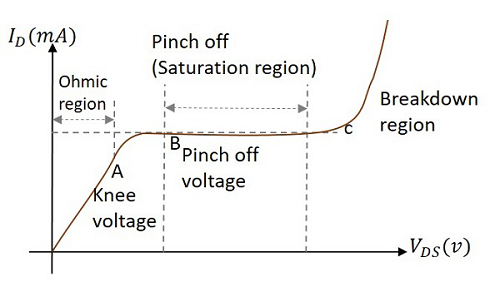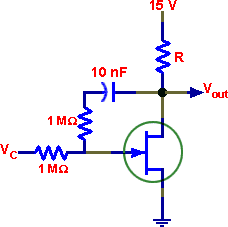JFET Variable Resistor
- Jfet As Voltage Variable Resistor
- Fet As Variable Resistor
- Jfet As Variable Resistor
- Jfet Can Be Used As Voltage Variable Resistor
- Jfet As Variable Resistor Model
- Variable Resistor Purpose
CIRCUIT
JFET_VARIABLE_RES1.CR Download the SPICE file
JFET_VARIABLE_ATTEN1.CR Download the SPICE file
Some designs call for a variable resistor such as variable gain amplifiers, attenuators and some guitar effect boxes. The main goal here is device whose resistance is some function of bias voltage. One such device is your basic JFET. For small signals, where the device operates in the linear (or ohmic) region, the resistance between the Drain and Source terminals (Rds) decreases as the gate voltage increases.
MOSFET as a variable resistor In this video we use a power MOSFET(IRFZ34N) as a variable resistor. 5 boards for about $22 in about 7 days https://www.pcbway. The JFET transistor is used in what’s known as common drain configuration (or source follower), and it only uses three resistors and two capacitors to create a mirror of the input signal in the output of the circuit. The setting is as follows: The Gate pin of the transistor acts as the input The Source pin of the transistor acts as the output. This means that a JFET can be employed as a voltage-variable resistor for small ac signals, typically those less than 100 mV. When it is employed in this way, it does not require a dc drain voltage from the supply. All that is required is an ac input signal. Questions of this topic.
A voltage-controlled resistor (VCR) may be defined as a three-terminal variable resistor where the resistance val-ue between two of the terminals is controlled by a voltage potential applied to the third. For a junction field-effect transistor (JFET) under certain operating conditions, the resistance of the drain-source. This means that a JFET can be employed as a voltage-variable resistor for small ac signals, typically those less than 100 mV. When it is employed in this way, it does not require a dc drain voltage from the supply. All that is required is an ac input signal. Questions of this topic.
IV CURVES
How can you determine the JFET resistance versus bias voltage? Nothing tells the story like the slope of the IV curve. Here's the basic circuit to develop these insightful graphs.
* GATE AND DRAIN VOLTAGE
VG 1 0 DC 0
VD 2 0 DC 0
J1 2 1 0 J2N5952
*
* Nested DC sweep
.DC VD -0.05 0.05 0.1 VG -1.75 0 0.25
The file includes an essential line - the nested DC sweep command.
.DC V1 Start Stop Incr V2 Start Stop Incr

You define how the test voltages V1 and V2 will start, stop and increment. Then, for each V1 voltage point, V2 will sweep through its entire range from start to stop. This comes in handy where the drain (VD) is swept through its range for every gate bias voltage (VG).
CIRCUIT INSIGHT Run a DC analysis of the 2N5952 JFET in the JFET_VARIABLE_RES1.CIR and plot the drain current ID(J1). The drain is only swept from -50mV to +50mV. You should see a nice family of curves representing the Id as a function of Vd for each value of Vg. The slope of each VI curve represents the Drain-Source resistance. What is the minimum resistance? The smallest slope (resistance) can be approximated by Rds = 50mV/30uA = 1.66k ohms. The largest slope is Rds = 50mV/250uA = 200 ohms. This shows the range of resistance possible when sweeping the gate from -1.75 to 0V. My book live setup for mac.
As warned earlier, this resistor-like operation applies only to small signals. What about larger signals? Increase the Vd sweep parameters to Start = -0.5V and Stop = +0.5V. What happens to the linearity of the IV plots?
Ntfs for mac driver.
Jfet As Voltage Variable Resistor
VARIABLE ATTENUATOR
Here's an application of a JFET taken straight out of a National app note. The JFET implements a voltage attenuator as one leg in a voltage divider.
The voltage divider ratio is defined by Vo/Vs = R2'/(R1+R2') where R2' is actually the parallel combo of R2 and Rds. For this example, setting R1=10k and R2=100k defines a small attenuation, even when the JFET is OFF (very high resistance)
CIRCUIT INSIGHT The gate voltage VG ramps from -2V to 0V while a 100mV (1kHz) sine wave is applied to the divider input. Run a TRANSIENT ANALYSISs of JFET_VARIABLE_ATTEN1.CIR and plot both the gate voltage (V3) and the output voltage V(2). At what gate voltage does Rds begin conducting and attenuating the signal? Where does the max attenuation occur? You can estimate Rds by measuring V(2) peaks and solving the divider equation for R2.
UPCOMING TOPICS
In a future topic, we'll use the variable resistor as part of a popular guitar effects pedal called the phase shifter.
SPICE FILES
Variable Resistor
Download the file or copy this netlist into a text file with the *.cir extension.
Fet As Variable Resistor
Download the file or copy this netlist into a text file with the *.cir extension.
Variable Attenuator

Jfet As Variable Resistor

© 2012 eCircuit Center Hard disk drives for mac.
Jfet Can Be Used As Voltage Variable Resistor
Introduction:
Jfet As Variable Resistor Model
The following section will explain in details about the FET as a Voltage Variable Resistor-(VVR).
FET as a Voltage Variable Resistor-(VVR):
Variable Resistor Purpose
- FET is a device that is usually operated in the constant-current portion of its output characteristics.
- But if it is operated on the region prior to pinch-off (that is where VDS is small, say below 100 mV), it will behave as a voltage-variable resistor (WE).
- It is due to the fact that in this region drain-to-source resistance RDS can be controlled by varying the bias voltage VGS.
- In such applications the FET is also referred to as a voltage-variable resistor or volatile dependent resistor.
- It finds applications in many areas where this property is useful.
- Figure shows the drain characteristic curves for a 2N 5951 in the ohmic region (i.e. for low VDS).
- From the characteristic curve it can be seen that RDS varies with VGS. For example, when VGS = 0, RDS = 133 ohm and when VGS = – 2 V, RDS = 250 ohm.
- Because of this a JFET operating in the ohmic region with small ac signals acts as a voltage-controlled resistance.
- Note that the drain curves shown in figure, extend on both sides of the origin.
- This means that a JFET can be employed as a voltage-variable resistor for small ac signals, typically those less than 100 mV.
- When it is employed in this way, it does not require a dc drain voltage from the supply. All that is required is an ac input signal.
